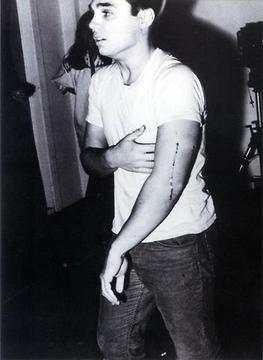
This picture is included in nearly every important book about the history of peformance art.
Now, this could have been a scandal at the time, but Chris Burden has since become a "serious person", or rather, a professor at the prestigious UCLA. The story would normally end there, but here is what I found (quoted from the L.A. Times, found in volokh's blog):
Internationally known artists Chris Burden and Nancy Rubins have retired abruptly from their longtime professorships at UCLA in part because the university refused to suspend a graduate student who used a gun during a classroom performance art piece, a spokeswoman for the artists said Friday.
"They feel this was sort of domestic terrorism. There should have been more outrage and a firmer response," said Sarah Watson, a director at [the gallery that] represents Burden and Rubins. . . .
The brief performance involved a simulation of Russian roulette, in which the student appeared before the class holding a handgun, put in what appeared to be a bullet, spun the cylinder, then pointed the gun at his head and pulled the trigger, according to one student's account that was confirmed by law enforcement sources. The weapon didn't fire. The student quickly left the room, then the audience heard a shot from outside. . . .
The Los Angeles County district attorney's office determined Friday that there was insufficient evidence to bring criminal misdemeanor charges . . . .
Lawrence Lokman, UCLA's assistant vice chancellor for communication, said the dean of students' office was continuing to investigate whether university rules against weapon possession were violated, which could lead to disciplinary action. . . .
Burden made his name in the early 1970s with influential and controversial performance art. In his best-known piece, "Shoot," performed in a Santa Ana gallery while he was a graduate student at UC Irvine, Burden had an assistant stand 15 feet away and shoot him in the upper arm with a .22-caliber rifle.
Watson said Burden's work was controlled and that the audiences never felt in jeopardy. The UCLA case is different, she said, because it was a surprise action and "there was genuine fear."
Even before the incident, Watson said, Burden and Rubins were unhappy at UCLA . . . .
Campus police said that in the course of the investigation, [the student] handed over a gun that was not a real firearm. Robison, the district attorney's spokeswoman, said there was "insufficient evidence to show a gun was discharged or any bullet fired." . . .
Barbara Drucker, who chairs the art department, and Ron Athey, a visiting instructor who taught the course and was present during the performance, conducted a meeting at the Warner Building a week after the incident to dispel rumors and allow students to air any concerns, as well as to emphasize rules against possessing weapons on university property . . . . Athey, known for piercing and cutting his body as a form of performance, did not return calls.
A graduate student who attended the meeting said a few students expressed safety concerns but more were alarmed that the university, if it disciplined the artist, would be cracking down on freedom of expression. . . .
Wow. now this is GREAT stuff! Not often do you get such a direct confrontation of an artist with the world he has participated in creating. At first it might seem like Burden is a hypocrite, not allowing others to do what he did himself some years ago. One of these ex-hippie parents trying to keep their children disciplined (not that they shouldn't).
But if you think about it, the situation is slightly different: there is a difference between freedom of expression and freedom of chosing suicide. You are not (legally, socially, some will say - morally) allowed to put your life at risk. Some artists do that - and did that. Burden never actually went that far. And if you look closely at the body art of the 60's and 70's, practically nobody really did. Marina Abramovic, for instance, came pretty close on several occasions, but she never actually insinuated she was going to kill herself. Schwarzkogler, one of the Vienna Actionists, died, but not in an "artistic suicide". His work was not about suicide and taking one's life. There are many other examples.


